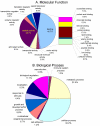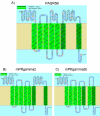Analysis of the goldfish Carassius auratus olfactory epithelium transcriptome reveals the presence of numerous non-olfactory GPCR and putative receptors for progestin pheromones
- PMID: 18803863
- PMCID: PMC2556351
- DOI: 10.1186/1471-2164-9-429
Analysis of the goldfish Carassius auratus olfactory epithelium transcriptome reveals the presence of numerous non-olfactory GPCR and putative receptors for progestin pheromones
Abstract
Background: The goldfish (Carassius auratus) uses steroids and prostaglandins as pheromone cues at different stages of the reproductive cycle to facilitate spawning synchronization. Steroid progestin pheromone binding has been detected in goldfish olfactory membranes but the receptors responsible for this specific binding remain unknown. In order to shed some light on the olfactory epithelium transcriptome and search for possible receptor candidates a large set of EST from this tissue were analysed and compared to and combined with a similar zebrafish (Danio rerio) resource.
Results: We generated 4,797 high quality sequences from a normalized cDNA library of the goldfish olfactory epithelium, which were clustered in 3,879 unique sequences, grouped in 668 contigs and 3,211 singletons. BLASTX searches produced 3,243 significant (E-value < e(-10)) hits and Gene Ontology (GO) analysis annotated a further 1,223 of these genes (37.7%). Comparative analysis with zebrafish olfactory epithelium ESTs revealed 1,088 identical unigenes. The transcriptome size of both species was estimated at about 16,400 unigenes, based on the proportion of genes identified involved in Glucose Metabolic Process. Of 124 G-protein coupled receptors identified in the olfactory epithelium of both species, 56 were olfactory receptors. Beta and gamma membrane progestin receptors were also isolated by subcloning of RT-PCR products from both species and an olfactory epithelium specific splice form identified.
Conclusion: The high similarity between the goldfish and zebrafish olfactory systems allowed the creation of a 'cyprinid' olfactory epithelium library estimated to represent circa 70% of the transcriptome. These results are an important resource for the identification of components of signalling pathways involved in olfaction as well as putative targets for pharmacological and histochemical studies. The possible function of the receptors identified in the olfactory system is described. Moreover, the role of olfactory epithelium specific isoforms of classical membrane progestin receptor genes as candidates for preovulatory pheromone sensing is discussed.
Figures




Similar articles
-
Cloning and localization of two multigene receptor families in goldfish olfactory epithelium.Proc Natl Acad Sci U S A. 1998 Sep 29;95(20):11987-92. doi: 10.1073/pnas.95.20.11987. Proc Natl Acad Sci U S A. 1998. PMID: 9751777 Free PMC article.
-
Molecular characterization of novel interferon gamma receptor 1 isoforms in zebrafish (Danio rerio) and goldfish (Carassius auratus L.).Mol Immunol. 2009 Sep;46(15):3050-9. doi: 10.1016/j.molimm.2009.06.004. Epub 2009 Jul 3. Mol Immunol. 2009. PMID: 19577303
-
Identification and molecular characterization of the interleukin-10 receptor 1 of the zebrafish (Danio rerio) and the goldfish (Carassius auratus L.).Dev Comp Immunol. 2012 Feb;36(2):408-17. doi: 10.1016/j.dci.2011.08.006. Epub 2011 Aug 26. Dev Comp Immunol. 2012. PMID: 21906622
-
Diverse systems for pheromone perception: multiple receptor families in two olfactory systems.Zoolog Sci. 2008 Dec;25(12):1179-89. doi: 10.2108/zsj.25.1179. Zoolog Sci. 2008. PMID: 19267644 Review.
-
The goldfish (Carassius auratus) as a model for neuroendocrine signaling.Mol Cell Endocrinol. 2008 Oct 10;293(1-2):43-56. doi: 10.1016/j.mce.2008.06.017. Epub 2008 Jul 5. Mol Cell Endocrinol. 2008. PMID: 18657592 Review.
Cited by
-
Deep sequencing of the murine olfactory receptor neuron transcriptome.PLoS One. 2015 Jan 15;10(1):e0113170. doi: 10.1371/journal.pone.0113170. eCollection 2015. PLoS One. 2015. PMID: 25590618 Free PMC article.
-
Involvement of Membrane Progestin Receptor Beta (mPRβ/Paqr8) in Sex Pheromone Progestin-Induced Expression of Luteinizing Hormone in the Pituitary of Male Chinese Black Sleeper (Bostrychus Sinensis).Front Endocrinol (Lausanne). 2018 Jul 18;9:397. doi: 10.3389/fendo.2018.00397. eCollection 2018. Front Endocrinol (Lausanne). 2018. PMID: 30072952 Free PMC article.
-
Molecular and neuronal homology between the olfactory systems of zebrafish and mouse.Sci Rep. 2015 Jun 25;5:11487. doi: 10.1038/srep11487. Sci Rep. 2015. PMID: 26108469 Free PMC article.
-
De novo transcriptomes of olfactory epithelium reveal the genes and pathways for spawning migration in japanese grenadier anchovy (Coilia nasus).PLoS One. 2014 Aug 1;9(8):e103832. doi: 10.1371/journal.pone.0103832. eCollection 2014. PLoS One. 2014. PMID: 25084282 Free PMC article.
-
Molecular cloning and functional characterization of a zebrafish nuclear progesterone receptor.Biol Reprod. 2010 Jan;82(1):171-81. doi: 10.1095/biolreprod.109.077644. Epub 2009 Sep 9. Biol Reprod. 2010. PMID: 19741208 Free PMC article.
References
-
- Hara TJ. Feeding behaviour in some teleosts is triggered by single amino acids primarily through olfaction. J Fish Biol. 2006;68:810–825. doi: 10.1111/j.0022-1112.2006.00967.x. - DOI
-
- Blechinger SR, Kusch RC, Haugo K, Matz C, Chivers DP, Krone PH. Brief embryonic cadmium exposure induces a stress response and cell death in the developing olfactory system followed by long-term olfactory deficits in juvenile zebrafish. Toxicol Appl Pharm. 2007;224:72–80. doi: 10.1016/j.taap.2007.06.025. - DOI - PubMed
Publication types
MeSH terms
Substances
LinkOut - more resources
Full Text Sources
Molecular Biology Databases
Research Materials

